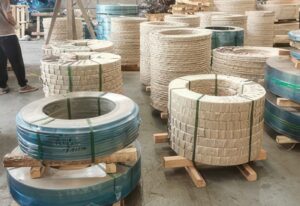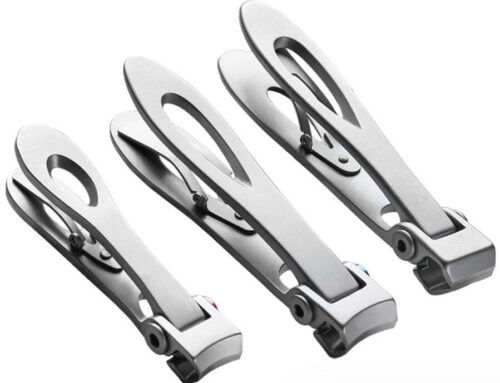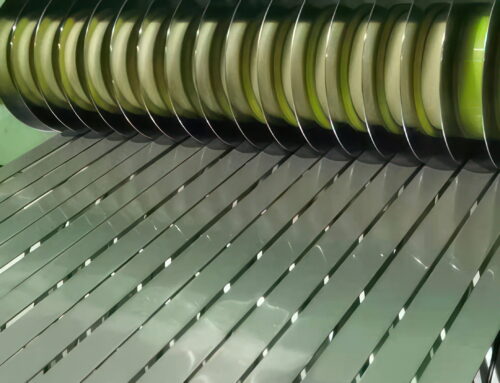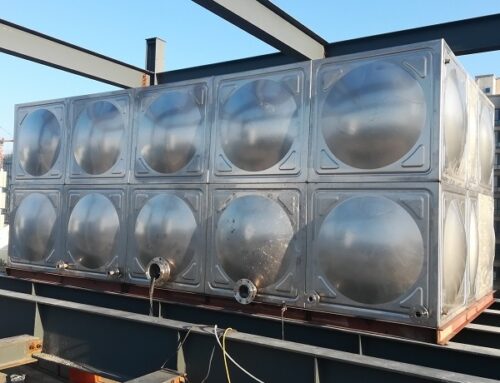
Packaging for Stainless Steel Strip
Many times my cliets tell me they want SS201 material for their products, but they seldom mention about which detial level.
That’s why often ask our clients where the material is used, then we can provide them the right grade.
Here list some difference about SS 201 for your reference.
J1: It has slightly higher carbon content than J4 and lower copper content than J4. Its workability is inferior to J4. It is suitable for ordinary shallow drawing and deep drawing products with large angle types, such as decorative plates, bathroom products, sinks, tubing, etc.
J2 & J5: They are still good for simple processing in decorative tubes because of their high hardness (above 96°), and the polishing is quite beautiful. However, they are prone to cracking when used in square tubes or bent tubes (90°).
In terms of flat plates, due to the high hardness, the plate surface is beautiful, and surface treatments such as sandblasting, polishing and plating are acceptable. But the biggest problem is bending. Bending is easy to break, and slotting is easy to burst, so the ductility is poor.
J3: It contains high carbon, low chromium and low copper. However, due to its high carbon content and low copper content, the material is slightly harder. Therefore, it is not suitable for bending with slightly higher strength. Compared with 201 stainless steel J1, its ductility is not as good, and it is more prone to rust in the same environment.
In the narrow strip field, the emergence of 201 stainless steel J3 is more to meet the needs of pipe enterprises for corrosion resistance and deformation requirements that are not particularly high. Because it can reduce the raw material costs of pipe enterprises, it has been sought after by pipe enterprises in the narrow strip field.
J3 can be easily processed for decorative plates, but more difficult. Some skilled workers have said that using J3 steel to cut and bend plates will have internal seams after breaking (for black titanium, colored plates, sandblasted plates, breaking and bending out internal seams). Sinks have been tried for bending, 90 degrees is OK, but not continuous.
J4: J4 is a high-end product in the 201 stainless steel J series. It is suitable for small-angle deep drawing products. Most deep drawing and stretching products requiring salt spray testing will choose it. Such as sinks, kitchenware, bathroom products, kettles, vacuum flasks, door hinges, pots, etc.
Chemical compositions:
201 j1: Cr 17-19%, Ni 3.5-5.5%, Mn 5.5-7.5%, C ≤0.15%
201 j2: Cr 17-19%, Ni 3.5-5.5%, Mn 5.5-7.5%, C 0.15-0.25%
201 j3: Cr 17-19%, Ni 3.5-5.5%, Mn 6-8%, C 0.25-0.35%
201 j4: Cr 17-19%, Ni 3.5-5.5%, Mn 7-9%, C 0.3-0.4%
201 j5: Cr 17-19%, Ni 3.5-5.5%, Mn 7-9%, C 0.4-0.5%, N 0.05-0.15%
Characteristics:
With increasing carbon and manganese content from 201 j1 to 201 j5, the hardness, strength, hot workability and corrosion resistance increase, while the plasticity decreases. 201 j5 has the highest strength due to nitrogen alloying.
Applications:
201 j1: springs, wires (lowest strength, best cold workability)
201 j2, 201 j3: building materials (moderate properties)
201 j4: springs, wires
201 j5: springs, valves, bolts (highest strength, poorest cold workability)
Summary:
Copper content:J4>J1>J3>J2>J5.
Carbon content:J5>J2>J3>J1>J4
Hardness arrangement:J5,J2>J3>J1>J4
The order of prices from high to low is:J4>J1>J3>J2,J5.
In summary, the major differences of 201 j1 to 201 j5 stainless steels are chemical compositions and characteristics. Their applications vary from building materials to springs and bolts depending on their specific properties. Please let me know if you need more details. I am happy to provide more information.





Leave A Comment